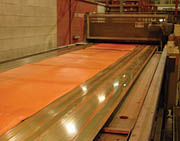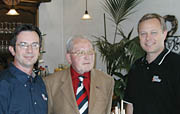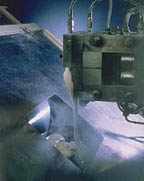A History of Powder Coatings

The concept of applying an organic polymer in powder form dates back to the late 1940s and early 1950s when powders were flame-sprayed on metallic substrates. During this time, Dr. Erwin Gemmer, a German scientist, developed the fluidized bed application for thermoplastic resins on metal as a more efficient alternative to flame spraying. A patent application for this new process was filed in Germany in May 1953, and the patent was issued in September 1955.
Between 1958 and 1965, virtually all powder coatings were applied by the fluidized bed process. Most of the applications were functional in nature, providing film thicknesses of 6 to 20 mils. These thick-film applications were generally for electrical insulation, as well as for corrosion- and abrasion-resistant purposes. Coating materials consisted of nylon 11, CAB, polyethylene, plasticized PVC, polyester and chlorinated polyether, among others.
While fluidized beds were being used throughout the United States and Europe, other application methods were being introduced. These were developed to meet the need for systems with wider commercial use.

The EPS process
The EPS processIt's well known that traditional liquid paints contain solvents, which pollute the environment. Their percentages are often very high, especially in spraying paints. So, while working for Teodur (now part of DuPont Powder Coatings) in 1960, I started to look for nonpolluting, environmentally friendly stoving enamels for industrial applications.
I had three possibilities in mind: reducing the percentage of solvents from 50 to 60% to 20 to 30%; substituting 90 to 95% of the solvents with water; or substituting all of the solvents with air.
The first two possibilities had (and have) the disadvantage of containing polluting solvents. The third possibility brought me to the development of powder coatings, which do not contain any solvent.
My line of thought was this: Find suitable solid resins, hardeners, pigments and other materials, and try to blend them. Then, grind them to a powder with a suitable particle size, bring the powder into a vessel with a porous bottom, and blow air through it so that the powder mix is "fluidized" and behaves like a liquid.
I knew about this fluidization technique from the petrochemical industry and from the invention of the fluidized bed coating technique of powder PVC onto preheated metal surfaces. Moreover, I knew that talcum powder was electrostatically sprayed on tires in France.
If I succeeded in making paint in powder form, the fluidized powder must be sprayable (like French talcum powder) from an electrostatic gun (already known from the wet paint application technique), and it should be possible to apply the powder to a grounded metal object. The in-the-gun, electrostaticlly charged powder particles would then adhere to the metal surface, after which the powder layer could be fused and cured.
In this way, air takes over the liquefying function of solvents. A better ecological method was unthinkable!

Humble beginnings
My line of thought appeared to be right and I succeeded (with the aid of Shell, which supplied the suitable solid epoxy resins) to develop primitive powder coatings. These first systems were relatively simple, physical dry blends of powdered epoxy resins, hardeners and pigments dispersed by ball-milling techniques. Due to a considerable degree of heterogeneity, the application results were rather inconsistent.Soon I found out that, for more homogeneous mixtures of the raw materials, hot-melt compounding on a heated twin-roller mill or in a heated Z-blade mixer was the necessary technique.
After a period of trial and error and real pioneering work between 1961 and 1962, I was able to bring worldwide the first electrostatically sprayable, decorative thermosetting powder coating (made by hot-melt compounding in a Z-blade mixer) to the market under the trade name "Teodur DM." The first application of this Teodur DM epoxy/dicyandiamide powder coating was for hospital furniture. Its stoving scheme was 30 minutes at 350°F.
In the early years, the powder coating processing method incorporated mixing, extrusion and milling in one manufacturing step. This method is still being used for some specialty products, such as low-gloss textured powders. Unfortunately, particle size control is poor and products processed in this manner show poor application characteristics (fluidization, impact fusion, transfer efficiency and others).
Other early methods to produce powder coatings were two-roll mills, and Sigma mixers for melt mixing. Product output was low for both types of equipment, and Sigma mixers needed extensive cleanup after each batch.
Extrusion methods for producing thermosetting powder coatings were further developed by Shell from 1962 to 1964. In the same period, SAMES in France developed the first equipment for electrostatic spraying of organic powder coatings by improving their existing electrostatic gun.
In the late 1960s and early 1970s, a method utilizing conventional liquid coating processing technologies for powder coatings was studied and evaluated on a smaller scale. Resins and curatives suitable for producing powder coatings were dissolved in solvents. Then pigments, fillers and additives were added and the resulting mixes were processed on conventional equipment like any other solventborne paint. To turn these products into powder, a spray-drying process was used that recovered most of the solvents. However, some solvent losses resulted, defeating the purpose of having a cleaner manufacturing process.
One that got away
In the late 1970s, a unique application technique was developed, but it never caught on in the market. Already processed powder coatings (mostly epoxy-based) were further dispersed and ground in a sandmill with water and surfactants. The resulting slurry would be sprayed using conventional application equipment and, after baking, the coated films looked and performed virtually the same as powder coated ones based on the same chemistries.
The most common complaint about powder slurry applications was that the material clotted during the spray operation. Although this can be overcome with proper handling and adjustment, the slurry process has had very limited use worldwide.

Mounting environmental pressures
As the powder coating finish continued to gain further acceptance, other issues involving coatings were coming to light in Europe. These issues would affect the way the industry, as a whole, would progress through the 1970s and into the present.The highly industrialized nations of Western Europe, with population densities of more than 1,000 people per square mile, were fighting ever-increasing air and water pollution hazards. The paint and coatings industries of these countries feared legislation similar to the "Los Angeles Rule 66," which placed strict limits on industrial emissions, and looked for low-VOC or non-VOC alternatives. They accelerated the research and development, not only into thermoset decorative powder coatings, but also into powder coating raw material, processing and application equipment.
By 1973, the original four basic chemistries-epoxy, carboxypolyester-epoxy hybrid (or, simply, hybrid), hydroxypolyester-(blocked) polyurethane (named polyester or polyurethane) and carboxypolyester-TGIC (or TGIC polyester)-were already established in, or introduced to, the European thermoset decorative powder coating markets. Some other chemistries evaluated during the same period, such as alkyd melamine and some acrylics, were short-lived because of stability, application and performance problems.
Powder coatings today
The dominant overall finishing trend will continue to be replacement of liquid finishing with powder coating for environmental impact reasons. Improvements in both coating and application technology will promote much broader powder use.The technology improvements are driven by needs primarily in the automotive, appliance and general industrial markets. The improvements encompass raw material, coating manufacturing and application sophistication changes.
The automotive industry continues to expand powder coating from under-hood, trim and wheels to body applications. Improvements in powder coatings for automotive use include clarity, adhesion, leveling and UV-resistance properties in clear coatings; lowered temperature cure without appearance and property sacrifices; and application sophistication incorporating robotics, airflow control and high transfer efficiency.
In the appliance arena, the use of precoated stock (blank and coil) offers dramatic growth potential for powder coatings. Here, powder coatings must melt, flow and level, and cure quickly (25 to 60 seconds) while retaining the aesthetic and resistance properties the appliance industry currently enjoys.
The coatings must also be post-formable with the degree of formability required being dependent on the end use. Application sophistication is also required to deposit even, thin films at line speeds of 30 to 80 fpm for blank coating and more than 100 fpm for coil coating. Again, airflow control/minimization and transfer or charging efficiency are critical.
Curing appearance-critical coatings at high line speeds is a major part of the technology improvement. Issues being addressed are matching infrared (IR) wavelength/intensity to coating and substrate; using combinations of IR, convection and induction curing to provide a rapid leveling and cure package with minimal powder surface interruption; and the overall cleanliness of the cure system.
As the automotive and appliance industries move to more sophisticated coatings and coating application systems, the need is for individual powder coatings to work with the process. This trend for designing coating and process, in concert, will continue to grow and spread to the general industrial market as applications once off-limits for powder (too many colors, too fast, too deep to penetrate and multiple coating layers) convert in growing numbers.
Other trends, influenced largely by the general industrial marketplace, are increased "stock product" offerings and greater availability of small custom batches. The proliferation of powder manufacturing equipment suppliers and the growth of raw material suppliers support the trend among regional paint suppliers to add powder manufacturing, while the maturing European market continues to provide new suppliers of both powder coatings and powder application equipment.
Overall, the increased number of suppliers will most benefit small- to medium-size powder users with price stability and greater product availability. However, the growing trend among large powder users to forge partnerships with single suppliers will continue to marry powder coating developments to the application process, as well as the end use requirements.
Much of the information contained in this article comes from Powder Coating: The Complete Finisher's Handbook, Second Edition, published by PCI.
SIDEBAR: A Powder Coating Timeline
Late 1940s-Flame spraying of thermoplastic powder developed.1953-Dr. Erwin Gemmer develops fluidized bed application and files for a patent.
1955-A patent is issued for fluidized bed application, and the method is introduced to the U.S. market.
1962 to 1964-The electrostatic spray process, developed by Pieter de Lange, enters the marketplace.
1950 to 1970-Various (thermoset) powder manufacturing methods are evaluated and used. The extrusion process becomes the method of choice.
1966 to 1970-The "Los Angeles Rule 66" and the Clean Air Act are introduced. Powder coating market objectives diverge in Europe and North America: Europe concentrates increasingly on thermoset decorative applications, North America on high-film-build functional markets, such as pipe coatings.
1966 to 1973-The four original thermoset chemistries-epoxy, hybrid, polyurethane and TGIC-are introduced and become commercially available. Some melamine and acrylic chemistries remain unsuccessful.
Early 1970s-Powder manufacture and use spread worldwide.
Late 1970s-The slurry application process is introduced but is unsuccessful. A rapid growth phase in powder production and use begins in Europe.
Early 1980s-A rapid growth phase in powder production and use begins in North America and Japan.
Mid-1980s-A rapid growth phase in powder production and use begins in the Far East.
1985 to present-New powder coating chemistries are introduced. Various types of resin systems and crosslinkers become commercially available. Application equipment improvements lead to increased transfer efficiency, reduced waste and lower overall costs.
Looking for a reprint of this article?
From high-res PDFs to custom plaques, order your copy today!





